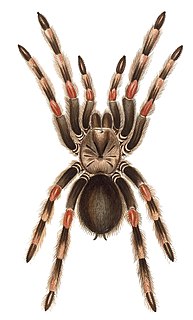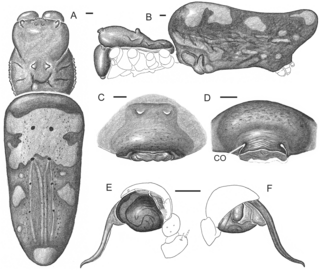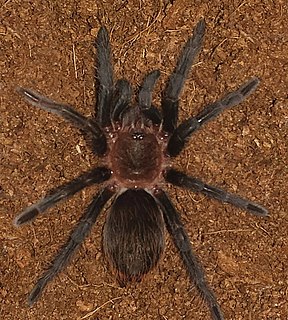
Nursery web spiders (Pisauridae) is a family of araneomorph spiders first described by Eugène Simon in 1890. They resemble wolf spiders (Lycosidae) except for several key differences. Wolf spiders have two very prominent eyes in addition to the other six, while a nursery web spider's eyes are all about the same size. Additionally, female nursery web spiders carry their egg sacs with their jaws and pedipalps instead of attaching them to their spinnerets as wolf spiders do. When the eggs are about to hatch, a female spider builds a nursery "tent", places her egg sac inside, and stands guard outside, hence the family's common name. Like the wolf spiders, however, the nursery web spiders are roaming hunters that don't use webs for catching prey. They have a wide variety of prey, and larger species may prey upon vertebrates, particularly amphibians and fish.

Brachypelma smithi is a species of spider in the family Theraphosidae (tarantulas) native to Mexico. It has been confused with Brachypelma hamorii; both have been called Mexican redknee tarantulas. Mexican redknee tarantulas are a popular choice as pets among tarantula keepers. Many earlier sources referring to B. smithi either relate to B. hamorii or do not distinguish between the two species. B. smithi is a terrestrial tarantula native to Pacific coast of the Mexican state of Guerrero.

Cyriopagopus schmidti is a species of spider in the family Theraphosidae (tarantulas), found in China and Vietnam. It is one of a number of species known as "Chinese bird spider" and "Chinese earth tiger". Haplopelma huwenum was synonymized with this species in 2008. Spiders under this name and its synonyms have been shown to produce toxins called huwentoxins.

Heterixalus boettgeri is a species of frog in the family Hyperoliidae. It is endemic to Madagascar and occurs in the extreme southeastern and southern parts of the island. The specific name boettgeri honours Oskar Boettger, a German zoologist. Common name Boettger's reed frog has been coined for it.
Neischnocolus is a genus of spiders in the family Theraphosidae. It was first described in 1925 by Petrunkevitch. The genus Ami was separately described in 2008, but was later discovered to be a junior synonym of Neischnocolus. Species are native to Central America and northern South America.

Nephila komaci is a species of golden orb-web spider. It is the largest web-spinning spider known. A few specimens have been found in South Africa and Madagascar.

Progradungula otwayensis, commonly known as the odd-clawed spider, is a species of cribellate spider endemic to the Great Otway National Park of Victoria, Australia. It is one of only two species in the gradungulid genus Progradungula.

Padava laminata is a species of araneomorph spider in the family Titanoecidae. It is widely distributed from East Africa through China to New Guinea and the Marquesas Islands.
Callulops mediodiscus is a species of frog in the family Microhylidae. It is only known from the type locality in the upper Kikori Basin in the Southern Highlands Province, Papua New Guinea. The specific name refers to its most distinctive feature, the moderately enlarged discs on fingers and toes, although their function remains unknown as the specimens were collected on or near the ground.
Entypesa is a genus of African mygalomorph spiders in the family Entypesidae. It was first described by Eugène Louis Simon in 1902. Originally placed with the curtain-web spiders, it was transferred to the funnel-web trapdoor spiders in 1985, then to the Entypesidae in 2020. It is a senior synonym of Pseudohermacha.

Avicularia juruensis is a species of spider in the family Theraphosidae, found in South America. Avicularia urticans was brought into synonymy in 2017. It has been given the English name Amazonian pink toe spider. Under the synonym Avicularia urticans, it is also known as the Peruvian pinktoe tarantula. It is a large mygalomorph spider, with a maximum body length over 30 mm (1.2 in) and the longest fully extended leg about 60 mm (2.4 in). Like other species in the genus Avicularia, specimens under this name are sold as pets, although their identity has not been confirmed by taxonomic studies.
Chrysilla guineensis is a species of jumping spider. It is endemic to Guinea. It was described in 2013 based on specimens collected from the Nimba Mountains.

Tliltocatl verdezi is a species of spiders in the family Theraphosidae (tarantulas), found in Mexico.
Spiroctenus personatus is a spider in the family Bemmeridae, found in Southern Africa. It was first described in 1889 by Eugène Simon. The male specimen that Simon described was from Maputo Bay, which he called "Baie de Delagoa", in Mozambique. It was about 20 mm long. Its cephalothorax was light grey with a black triangular head region and a brownish centre. The fovea was large. The abdomen was short and oval, the upper surface being black with yellowish markings, the lower pale brick-coloured. The legs were brownish-olive with reddish patellae. The palpal bulb was pear-shaped with a very delicate long embolus.
Caponina papamanga is a species of araneomorph spider from the Brazilian Amazonia. It is the first species of the genus Caponina from the region. It belongs to the family Caponiidae, which is described as ecribellate and haplogyne.
Cladomelea akermani is a species of spider in the orb-weaver spider family Araneidae, found in South Africa. Cladomelea species, including C. akermani, are "bolas spiders" – adult females capture their prey by using a sticky drop on the end of a single line which they swing, usually catching male moths attracted by the release of an analogue of the attractant sex pheromone produced by the female moth. Juvenile and adult male bolas spiders do not use a bolas, catching prey with their legs alone.

Cyrtarachne inaequalis is a species of spider in the orb-weaver spider family Araneidae, found in India, Myanmar, China and Korea. Spiders in the genus Cyrtarachne construct "spanning-thread webs" rather than the more typical orb webs of the family Araneidae. These webs have a small number of radii and instead of a tight spiral of sticky threads, the sticky spanning threads are widely spaced and do not form a spiral. When prey is caught on one of the spanning threads, one end comes loose, and the prey, often a moth, dangles from the other end until hauled in by the spider.
Exechocentrus lancearius is a species of spider in the orb-weaver spider family Araneidae, found only in Madagascar. It was initially described from a partial specimen of an adult female. The first description of a complete specimen and its prey-catching behaviour was published in 2012. E. lancearius is a bolas spider. Rather than using a web, adult females catch their prey by using a line with one or two sticky drops which they swing.

Pasilobus hupingensis is a species of spider in the orb-weaver spider family Araneidae, found in China and Japan. Females of the genus Pasilobus construct "spanning-thread webs" with only two sectors, making them appear triangular. Widely spaced threads with sticky drops span the three radii of these webs. One end is attached in such a way that it readily breaks free. When a prey item is caught on one of these threads, the line parts at this end and the prey hangs from the web until it is hauled up by the spider.










